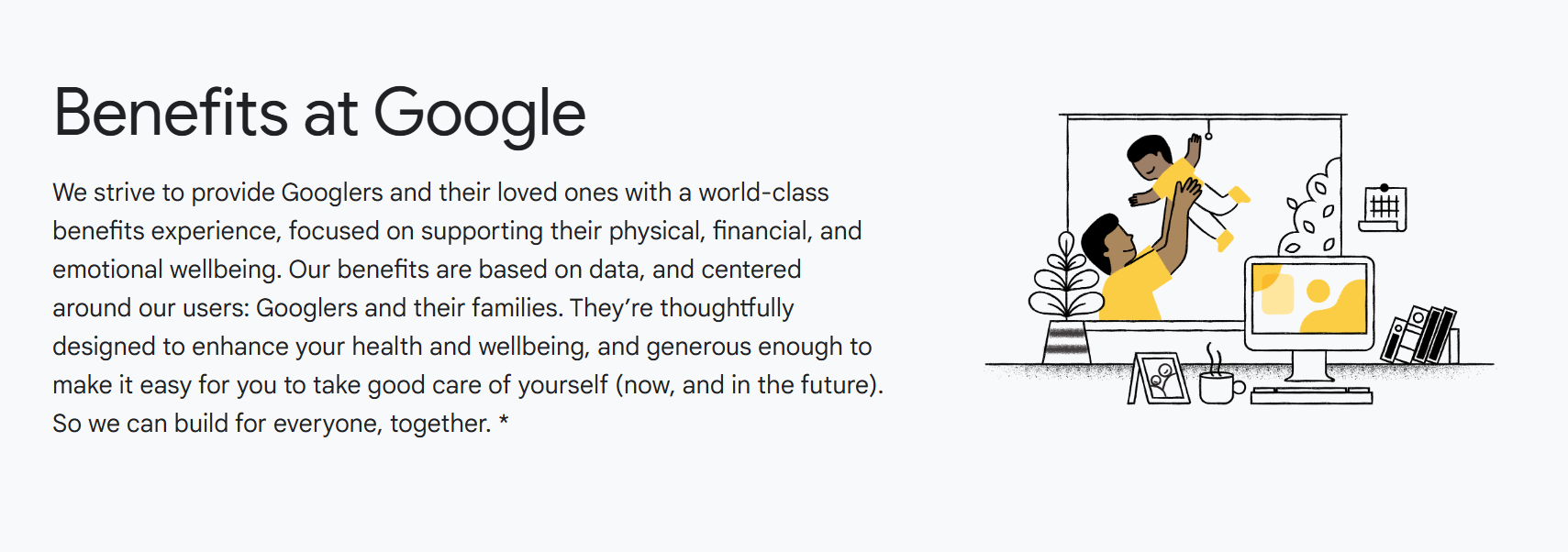Panduan Komprehensif untuk Opsi Imbalan Kerja Terbaik untuk Tahun 2025
Pilihan Tunjangan Karyawan mencakup jenis-jenis penting dan praktik terbaik untuk menyusun paket yang kompetitif.
Di halaman ini
- Memahami manfaat bagi karyawan
- Jenis-jenis manfaat
- Dampak dari opsi imbalan kerja karyawan
- Contoh perusahaan terkemuka
- Cara untuk meningkatkan kepuasan karyawan
- Fasilitas penting yang harus diketahui oleh setiap praktisi sumber daya manusia
- Praktik-praktik terbaik untuk opsi tunjangan karyawan Anda:
- Manfaat yang diamanatkan secara hukum:
- Analisis kasus: opsi tunjangan karyawan di Drizly
- Kesimpulan
- Bungkus
- Pertanyaan Umum
Sekarang, lebih dari sebelumnya, paket tunjangan karyawan dianggap penting untuk menghadapi medan yang berat di pasar kerja saat ini. Hanya organisasi yang memahami cara menggunakan pendekatan yang paling ampuh ini untuk keuntungan mereka dengan menyertakan tunjangan komprehensif dalam bentuk barang yang dapat bersaing di pasar untuk mendapatkan dan mempertahankan tenaga kerja terbaik.
A Glassdoor 2023 menemukan bahwa, berdasarkan sentimen lebih dari 1.100 orang dewasa di Amerika Serikat, para pencari kerja memang menghargai tunjangan saat mempertimbangkan peluang. Tren ini menggarisbawahi peran penting penataan paket tunjangan yang baik dalam memengaruhi daya tarik perusahaan bagi calon karyawan dan karyawan saat ini.
Ambil contoh sebuah perusahaan teknologi terkemuka di mana, hanya dengan memperkenalkan waktu fleksibel bagi karyawannya, memungkinkan mereka bekerja dari rumah, dan tunjangan kesehatan yang jauh lebih baik, seluruh pendekatan dalam menerapkan tunjangan karyawan telah berubah.
Terlihat dari penurunan tingkat turnover secara signifikan, rencana yang baru diperkenalkan memiliki hasil yang mengejutkan, menghasilkan peningkatan sebesar 25% dalam kepuasan karyawan. Oleh karena itu, hal ini merupakan cara yang sangat baik untuk membuat karyawan merasa bahwa mereka diperhatikan dengan paket tunjangan yang baru ini, yang akan meningkatkan keterlibatan karyawan dan dengan demikian meningkatkan retensi mereka.
Dalam panduan menyeluruh ini, kami melihat opsi terbaik yang tersedia terkait Opsi Tunjangan Karyawan di tahun 2024, berbagai jenis, dan signifikansinya, serta praktik terbaik dalam merancang paket tunjangan yang sesuai dengan kebutuhan tenaga kerja.
Memahami manfaat bagi karyawan
Pilihan-pilihan tunjangan karyawan menambah paket kompensasi reguler yang diterima karyawan dan merupakan bagian dari kompensasi non-upah yang diberikan kepada karyawan. Tunjangan ini meningkatkan kesejahteraan karyawan secara umum, yang pada gilirannya memberikan kontribusi utama pada kepuasan kerja; sehingga tunjangan ini sangat penting untuk pengembangan budaya organisasi dan membuat mereka merasa penting dan diperhatikan.
Paket tunjangan yang baik akan memenuhi semua kebutuhan karyawan terkait kesehatan, keamanan finansial, dan keseimbangan kehidupan kerja, namun juga menunjukkan kepedulian organisasi untuk menjaganya dengan baik. Hal ini akan menciptakan suasana kerja yang bersahabat dan meningkatkan semangat kerja karyawan secara umum.
Jenis-jenis manfaat
Ada berbagai jenis tunjangan karyawan yang diberikan kepada tenaga kerja di seluruh dunia.
- Asuransi kesehatan: Bisa dibilang, ini adalah prasyarat terpenting dari paket tunjangan yang baik. Ini akan membuat staf terlindungi dari segala macam fasilitas medis dan remunerasi untuk mengambil bagian dalam berbagai layanan kesehatan. Ini akan mencakup asuransi kesehatan komprehensif yang mencakup kunjungan dokter, rawat inap di rumah sakit, biaya obat resep, dan perawatan pencegahan.
- Cuti berbayar (PTO): PTO mencakup hari libur, cuti sakit, dan cuti pribadi. Semakin banyak kebijakan cuti berbayar, semakin baik karyawan menyeimbangkan antara pekerjaan dan kehidupan pribadi dan menghindari kelelahan karena menyatu dengan kepuasan kerja.
- Rencana pensiun: Pada dasarnya, ini adalah program pensiun-401(k) atau program pensiun-di mana karyawan menerima keamanan finansial selama masa kerja selain saat bertugas. Pencocokan pemberi kerja dapat membuat hal ini lebih menggiurkan, mendorong perasaan kesejahteraan finansial jangka panjang lebih jauh bagi karyawan.
- Program kesehatan: Program-program seperti ini membantu dalam kehidupan yang baik dan gaya hidup sehat bagi karyawan yang memiliki keterbatasan fisik dan mental. Karyawan dapat memperoleh manfaat seperti keanggotaan gym gratis, tantangan kesehatan, sumber daya kesehatan mental, atau kesempatan untuk mendapatkan konselor yang dapat diajak mengobrol.
- Struktur kerja yang fleksibel: Untuk tujuan ini, telecommuting, minggu kerja yang dipadatkan, dan jam kerja yang fleksibel mengaburkan perbedaan antara pekerjaan dan kehidupan pribadi dengan memungkinkan karyawan untuk secara efektif menangani pekerjaan mereka sambil memastikan tingkat integrasi kehidupan kerja yang lebih signifikan. Langkah-langkah tersebut meningkatkan kepuasan kerja dan produktivitas.
- Pengembangan profesional: Ini bisa berupa tunjangan pendidikan, program bimbingan, dan kesempatan pelatihan. Semua ini akan memperkuat pengembangan karier dan menunjukkan investasi perusahaan dalam kemajuan karyawannya, membuat mereka lebih puas dan cenderung tetap bersama perusahaan dari waktu ke waktu.
Dampak dari opsi imbalan kerja karyawan
Penggabungan manfaat menciptakan dampak langsung pada jiwa karyawan dengan cara berikut ini:
- Rekrutmen dan retensi: Tunjangan memainkan peran yang sangat besar dalam menarik talenta terbaik yang ada. Paket tunjangan yang menarik membuat perusahaan Anda lebih unggul dari perusahaan pesaing, sehingga membuat perusahaan semakin menarik bagi calon karyawan atau karyawan potensial.
Misalnya, perusahaan yang menawarkan tunjangan kesehatan lengkap ditambah dengan opsi kerja yang memungkinkan fleksibilitas dan pengembangan profesional akan diprioritaskan oleh para pencari kerja dibandingkan perusahaan lain.
Lebih jauh lagi, paket tunjangan yang efektif akan menuai hasil berupa tingkat retensi yang lebih tinggi dengan menciptakan kepuasan dan loyalitas kerja. Para pekerja tidak akan mudah keluar untuk mencari peluang lain di tempat lain ketika mereka merasa kebutuhan mereka terpenuhi dan kontribusi mereka sangat dihargai. - Dampak pada kepuasan dan produktivitas: Bahwa pilihan tunjangan terkait dengan kepuasan kerja telah didokumentasikan dengan sangat baik. Sebagian besar, pekerja yang memiliki akses ke paket tunjangan yang sangat kuat biasanya menunjukkan tingkat kepuasan dan keterlibatan yang lebih tinggi.
Mari kita bahas bagaimana perusahaan-perusahaan terkemuka memanfaatkan manfaatnya untuk meningkatkan kepuasan dan keterlibatan di antara para karyawan.
Contoh perusahaan terkemuka
Berikut ini adalah contoh-contoh perusahaan terkemuka yang unggul dalam tunjangan karyawan.
1. Netflix
Di Netflix, paket lengkap ditawarkan, mulai dari asuransi kesehatan hingga dukungan kesehatan mental dan cuti orang tua yang kuat. Karena alasan inilah pendekatan holistik menghasilkan kepuasan karyawan yang tinggi dan membantu mempertahankan talenta terbaik.

2. Microsoft

Microsoft akan mengakomodasi peluang kerja yang fleksibel yang akan memungkinkan staf untuk menyesuaikan jadwal kerja mereka agar sesuai dengan keadaan mereka, sehingga meningkatkan kepuasan mereka dengan pekerjaan mereka, dan mengarah pada peningkatan produktivitas.
3. LinkedIn

Hal ini dilakukan melalui tunjangan pendidikan, program bimbingan, dan lokakarya karier di LinkedIn. Pengembangan profesional ini tidak hanya membangun karyawan yang lebih baik, tetapi juga meningkatkan kepuasan kerja.
4. Google

Google menawarkan rencana pensiun yang sangat kuat dengan menyediakan karyawannya 401 (k) dan sumber daya perencanaan keuangan agar tidak merasa rentan terhadap masa depan, yang pada gilirannya meningkatkan loyalitas dan kepuasan jangka panjang mereka.
5. Tenaga penjualan

Salesforce: Penekanan Salesforce pada keseimbangan kehidupan kerja dimanfaatkan melalui beberapa tunjangan seperti waktu kerja sukarela berbayar, penggantian biaya kesehatan, dan kebijakan cuti orang tua yang sangat akomodatif. Semua ini dapat meningkatkan kualitas suasana kerja dan meningkatkan kepuasan.
Cara untuk meningkatkan kepuasan karyawan
Pilihan manfaat utama bagi karyawan untuk meningkatkan kepuasan karyawan dan praktik sumber daya manusia terbaik:
- Asuransi kesehatan: Kesehatan yang baik bagi karyawan tidak mungkin terjadi tanpa asuransi kesehatan yang komprehensif. Kategori ini bervariasi dari berbagai rencana dengan beberapa pilihan yang mencakup PPO, HMO, dan rencana kesehatan yang dapat dikurangkan. Menawarkan campuran dari rencana-rencana ini akan memberikan kesempatan bagi setiap karyawan untuk memutuskan mana yang terbaik untuk kebutuhan mereka.
- Rencana pensiun jangka panjang: Melalui tunjangan pensiun yang kuat seperti program 401(k) dengan pencocokan pemberi kerja, skema pensiun, dan ketersediaan sumber daya perencanaan keuangan, semua ini akan memberikan karyawan rasa aman secara finansial yang akan membawa kepuasan kerja dalam jangka panjang.
- Program kesehatan: Melalui berbagai kegiatan, program kesehatan membantu membina kesehatan fisik dan mental dengan menyediakan layanan yang berkaitan dengan keanggotaan gym, tantangan kesehatan, sumber daya kesehatan mental, dan program konseling.
- Pengaturan kerja yang fleksibel: dengan alternatif pekerjaan yang fleksibel, seperti telecommuting, waktu kerja fleksibel, dan minggu kerja yang dipadatkan, kemampuan karyawan untuk mengatasi masalah keseimbangan kehidupan kerja secara lebih efektif meningkat, sehingga meningkatkan kepuasan kerja.
- Relevansi: Semua jenis tunjangan adalah sarana untuk meningkatkan kepuasan di antara karyawan dan mendukung praktik sumber daya manusia yang terbaik. Asuransi kesehatan akan memberikan akses terhadap perawatan medis yang dibutuhkan, program pensiun yang mengamankan keuangan karyawan di masa depan, program kesehatan - meningkatkan kesehatan secara umum, dan pengaturan kerja yang fleksibel sehingga karyawan dapat menyeimbangkan kehidupan pribadi dan profesional mereka.
Fasilitas penting yang harus diketahui oleh setiap praktisi sumber daya manusia
Berikut ini adalah beberapa fasilitas penting yang dapat disertakan:
- Tunjangan pendidikan: Tunjangan pendidikan dan pengembangan profesional diberikan kepada karyawan yang mengikuti kegiatan yang meningkatkan karier. Tunjangan ini menggambarkan investasi yang dilakukan perusahaan dalam pertumbuhan dan perkembangan karyawan.
- Tunjangan kerja jarak jauh: Tunjangan untuk peralatan kantor di rumah dan penggantian biaya Internet disediakan di rumah untuk memfasilitasi pekerja yang bekerja jarak jauh, dengan menjaga agar semua pekerja jarak jauh memiliki perlengkapan yang tepat untuk melaksanakan tugas mereka secara efektif.
- Penggantian biaya kesehatan: Biaya keanggotaan gym, kelas olahraga, dan program atau layanan lainnya dapat diganti untuk memberikan insentif potensial bagi karyawan untuk menjaga kesehatan dan kesejahteraan mereka.
- Tunjangan yang disesuaikan: tawarkan menu tunjangan, yang memungkinkan setiap karyawan untuk memilih dari pilihan seperti rekening pengeluaran atau rekening tabungan kesehatan, sehingga memastikan bahwa paket tunjangan akan memenuhi kebutuhan dan preferensi individu.
Praktik-praktik terbaik untuk opsi tunjangan karyawan Anda:
Berikut ini adalah cara-cara untuk meningkatkan kepuasan karyawan:
- Inklusivitas dan fleksibilitas: Dengan beragamnya kebutuhan tenaga kerja saat ini, desain paket manfaat harus mempertimbangkan hal ini. Memiliki portofolio pilihan manfaat memastikan bahwa paket manfaat memenuhi kebutuhan karyawan yang berbeda, seperti pengaturan kerja yang fleksibel dan penyesuaian manfaat.
- Penyelarasan dengan nilai-nilai perusahaan: Buatlah paket manfaat untuk perusahaan dalam hal nilai dan budaya. Sebagai contoh, seseorang dapat memasukkan fasilitas kesehatan yang memadai di bawah paket tunjangan kesehatan perusahaan untuk organisasi yang mengutamakan kesehatan karyawan.
- Peninjauan dan pembaruan berkala: Setiap tinjauan terjadwal atas paket manfaat Anda dianggap tetap kompetitif dan relevan. Ikuti umpan balik karyawan dan tren organisasi yang diperbarui untuk memastikan Anda mengikuti perubahan industri.
- Komunikasi: Mengkomunikasikan paket manfaat kepada karyawan saat ini melalui buku panduan, pertemuan informasi, dan penggunaan sarana teknologi informasi. Pemeriksaan silang harus dilakukan untuk memastikan bahwa karyawan benar-benar memahami pilihan yang tersedia bagi mereka dan bagaimana cara mengaksesnya.
- Edukasi berkelanjutan: Teruslah mengedukasi staf tentang paket manfaat dengan perubahan atau jadwal yang diperbarui. Berikan informasi terbaru kepada karyawan secara berkala tentang penawaran baru dan bagaimana mereka dapat memanfaatkannya.
- Mekanisme umpan balik: Buatlah sistem umpan balik bagi karyawan mengenai apa yang mereka rasakan tentang paket tunjangan. Gunakan umpan balik ini untuk melakukan perbaikan yang diperlukan dan mengatasi masalah apa pun.
Manfaat yang diamanatkan secara hukum:
Berikut ini adalah praktik-praktik terbaik SDM untuk kepatuhan tunjangan karyawan:
- Asuransi kesehatan: Karyawan penuh waktu dan tanggungannya memerlukan asuransi sesuai dengan Undang-Undang Perawatan Terjangkau Amerika Serikat.
- Tunjangan pensiun: Pemberi kerja memenuhi persyaratan hukum tentang manfaat pensiun dengan mengelola program 401(k) yang sesuai dengan bantuan kontribusi pencocokan pemberi kerja yang sesuai.
- Cuti sakit berbayar: Di sebagian besar yurisdiksi, terdapat undang-undang yang mewajibkan pemberi kerja untuk memberikan cuti sakit berbayar.
- Peraturan setempat: Pastikan paket tunjangan Anda mencakup cuti sakit berbayar sesuai dengan peraturan setempat.
- Cuti keluarga: Pemberi kerja di Amerika Serikat harus memberikan cuti keluarga atau cuti medis yang sah berdasarkan Undang-Undang Cuti Keluarga dan Medis.
Kepatuhan
- Audit rutin: Sering-seringlah melakukan audit terhadap paket tunjangan, untuk memastikan bahwa perusahaan mematuhi semua persyaratan hukum. Pantau terus perubahan hukum dan peraturan dan masukkan setiap perubahan dalam program tunjangan Anda.
- Dokumentasi: Penawaran tunjangan dan upaya kepatuhan harus didokumentasikan dengan baik. Dokumentasi semacam itu dapat melindungi organisasi dari pertanyaan atau audit hukum.
- Konsultasi dengan para ahli: Berkolaborasi dengan pakar hukum dan SDM akan memastikan paket tunjangan Anda tidak hanya memenuhi semua persyaratan hukum, tetapi juga lebih jauh lagi dengan memasukkan praktik-praktik terbaik.
Analisis kasus: opsi tunjangan karyawan di Drizly
Bisnis teknologi tinggi yang berkembang pesat dan makmur ini perlu membangun dan memperluas paket tunjangan yang memadai bagi karyawan, seiring dengan bertambahnya tenaga kerja dan perubahan kebutuhan karyawan.
Drizly adalah layanan pengantaran online untuk minuman beralkohol yang menghadapi kebutuhan untuk mengunci penawaran manfaatnya, menjadikannya komprehensif, dan adaptif terhadap kapasitas di kantor dan jarak jauh, sekaligus mengamankan lingkungan kerja yang positif dan mendukung.
Tantangan yang dihadapi
- Adaptasi pertumbuhan: Sebagian besar dari pertumbuhan tersebut mengalami perubahan yang signifikan, terutama dalam ukuran dan struktur tenaga kerja Drizly. Perusahaan ini berada dalam tahap pertumbuhan dan perlu mengedit dan memperkaya program tunjangannya karena jumlah tenaga kerjanya yang meledak dan juga semakin beragam. Tantangannya adalah menciptakan program manfaat yang akan terus melanjutkan kemampuannya untuk menarik dan mempertahankan yang terbaik sekaligus menyelaraskan dengan tujuan dan nilai-nilai perusahaan.
- Menyeimbangkan beragam kebutuhan: Di satu sisi, staf Drizly merupakan campuran dari karyawan yang bekerja di kantor dan yang bekerja jarak jauh, masing-masing memiliki kebutuhan dan preferensi yang berbeda; tunjangan berada di sisi lain. Tantangannya di sini adalah merancang tunjangan yang memiliki nilai dan relevansi bagi kedua kelompok karyawan: karyawan jarak jauh dan karyawan kantor. Keseimbangan tersebut membutuhkan pendekatan yang tepat untuk memastikan manfaat yang setara dan inklusif antara karyawan jarak jauh dan staf di kantor.
Solusi yang diterapkan
Menyadari tantangan dalam pertumbuhan, Drizly mengimplementasikan paket manfaat yang telah ditingkatkan dengan komponen-komponen utama:
- Asuransi kesehatan: Drizly juga memperluas area yang dikerok dengan asuransi dalam hal kesehatan, sehingga rencana disipliner yang ditandatangani mencakup rencana medis, gigi, dan visual. Langkah ini sangat diperlukan untuk menyediakan akses karyawan yang berkualitas ke layanan medis yang tinggi dan dukungan kesejahteraan mereka.
- Rencana pensiun: Perusahaan juga meluncurkan program pensiun yang kuat yang mencakup program 401(k) dengan kontribusi yang sesuai dengan perusahaan dalam daftar. Hal ini akan membantu dalam memberikan kesempatan untuk menabung untuk masa depan dan meningkatkan keamanan ekonomi karyawan.
- Program kesehatan: Drizly memahami esensi kesejahteraan dalam hal aspek keseluruhan; oleh karena itu, Drizly menempatkan program-program yang menyentuh sumber daya kesehatan mental, keanggotaan kebugaran, dan inisiatif manajemen stres. Mandat dari program-program tersebut adalah untuk menciptakan keseimbangan antara pekerjaan dan kehidupan bagi para karyawan.
- Tunjangan karyawan yang ramah bagi pekerja jarak jauh: Anggota staf Drizly yang bekerja dari jarak jauh diberikan tunjangan untuk membantu mereka membayar apa pun yang dapat membantu produktivitas mereka lebih baik saat bekerja dari rumah. Dukungan seperti itu kepada staf membantu menciptakan minat bagi karyawan dalam membangun lingkungan kerja yang kondusif dan meningkatkan pengalaman kerjanya.
Drizly menyelenggarakan kegiatan pembangunan tim virtual untuk menjaga persatuan tim dan meningkatkan kesepakatan kerja jarak jauh di antara karyawan. Kegiatan ini mencakup banyak pertemuan sosial virtual online, tantangan tim, dan lokakarya interaktif di mana karyawan jarak jauh dapat berjejaring dengan kolega mereka. - Manfaat yang dipersonalisasi: Karyawan dapat memilih program kesehatan mana yang dapat mereka ikuti sesuai dengan kebutuhan dan harapan masing-masing. Ini termasuk pilihan keanggotaan gym, layanan kesehatan mental, dan pelatihan kesehatan.
- Program penggantian biaya pendidikan: Drizly memprakarsai program penggantian biaya pendidikan untuk pengembangan profesional karyawan. Manfaat ini memungkinkan karyawan untuk melanjutkan pendidikan dan/atau memperoleh sertifikasi atau pelatihan yang relevan dengan peran mereka masing-masing, sehingga memperkaya keterampilan dan karier mereka.
Hasil
- Peningkatan retensi karyawan: Paket tunjangan yang komprehensif dan fleksibel meningkatkan retensi karyawan. Dengan memenuhi berbagai kebutuhan tenaga kerjanya melalui tunjangan yang relevan, Drizly mempertahankan talenta yang penting secara internal, sehingga mengurangi tingkat pergantian karyawan. Lebih banyak staf yang merasa diperhatikan dan dihargai; oleh karena itu, ada tingkat kepuasan kerja dan loyalitas yang lebih tinggi.
- Budaya kerja yang positif: Tunjangan di Drizly memberikan banyak hal untuk budaya kerja yang positif dan inklusif. Dengan menerapkan tunjangan yang ramah bagi pekerja jarak jauh, tunjangan yang disesuaikan, dan semua yang menyertainya, tunjangan ini terus memperkuat budaya dan semakin menyatukan semua kolega di perusahaan-di mana pun mereka bekerja. Hal ini menciptakan satu komunitas pekerja yang terlibat.
- Merek perusahaan yang menarik: Peningkatan strategis pada paket tunjangan ini semakin meningkatkan reputasi Drizly yang kuat di pasar talenta yang kompetitif. Perusahaan ini sangat berkomitmen untuk menyediakan paket tunjangan yang komprehensif dan fleksibel, yang akan mencitrakan perusahaan sebagai tempat yang tepat untuk bekerja-sejalan dengan tujuannya untuk merekrut talenta terbaik dan menonjol dari para pesaingnya.
Kesimpulan
Pendekatan strategis terhadap tunjangan karyawan di Drizly secara efektif menjawab tantangan yang terkait dengan pertumbuhan bisnis dan karyawan yang beragam. Paket tunjangan yang lengkap dan dapat disesuaikan membantu mereka meningkatkan tingkat retensi karyawan, menumbuhkan budaya kerja yang positif, dan meningkatkan reputasi perusahaan sebagai pemberi kerja yang sangat kompetitif.
Apa yang dilakukan oleh contoh ini adalah mengajarkan perusahaan lain cara menyesuaikan penawaran tunjangan karyawan mereka agar sesuai dengan kebutuhan pekerja yang terus berubah sehingga mereka dapat membangun merek perusahaan yang lebih besar, Karen Morton.
Bungkus
Singkatnya, paket tunjangan yang kompetitif akan meningkatkan kepuasan karyawan, menarik talenta terbaik, dan mengembangkan budaya positif di tempat kerja. Seperti yang telah disebutkan sebelumnya, pengetahuan tentang berbagai jenis tunjangan karyawan dan mengapa tunjangan tersebut sangat penting akan sangat membantu dalam menggunakan praktik terbaik untuk merancang paket tunjangan yang akan memenuhi kebutuhan karyawan dan selaras dengan tujuan organisasi.
Oleh karena itu, hal ini akan memberikan banyak informasi mengenai peningkatan paket manfaat Drizly pada saat pertumbuhan yang sangat pesat. Hal ini menunjukkan bahwa Drizly dapat memberikan serangkaian manfaat yang lengkap dan sangat dapat disesuaikan untuk meningkatkan kepuasan karyawan, meningkatkan tingkat retensi, dan menangani merek perusahaan yang lebih kuat.
Untuk mempelajari lebih dalam tentang bagaimana Anda dapat mengoptimalkan paket tunjangan karyawan Anda, jadwalkan demo dengan para ahli kami di Empuls by Giift. Biarkan kami membantu Anda dalam merancang dan melaksanakan program tunjangan yang akan mendorong kepuasan pekerja dengan dukungan untuk mencapai tujuan organisasi Anda.
Pertanyaan Umum
Apa saja jenis tunjangan karyawan utama untuk tahun 2024?
Tunjangan umumnya terbagi dalam lima kategori besar: asuransi kesehatan, program pensiun, cuti berbayar, program kesehatan, dan pengaturan kerja yang fleksibel. Semua tunjangan ini membantu dalam berbagai cara dalam hal kesejahteraan karyawan dan menjaga keseimbangan yang tepat antara kehidupan dan pekerjaan.
Mengapa perusahaan sangat menghargai tunjangan karyawan?
Tunjangan karyawan sangat penting untuk menarik dan mempertahankan talenta terbaik, meningkatkan kepuasan kerja, dan meningkatkan produktivitas. Paket tunjangan yang kompetitif membantu menciptakan lingkungan kerja yang positif dan mengurangi tingkat pergantian karyawan.
Bagaimana tunjangan karyawan mempengaruhi kepuasan karyawan?
Hal ini menyiratkan bahwa tunjangan karyawan yang memadai meningkatkan kepuasan terhadap pekerjaan mereka karena kebutuhan karyawan seperti kesehatan, keamanan, dan keseimbangan kehidupan kerja terpenuhi. Karyawan yang puas lebih mungkin untuk terlibat dan berkomitmen terhadap pekerjaannya.
Apa saja contoh tunjangan karyawan yang inovatif?
Ini termasuk tunjangan yang mirip dengan Netflix: tunjangan kerja jarak jauh, penggantian biaya kesehatan, dan tunjangan pendidikan. Dua contoh perusahaan yang menawarkan tunjangan inovatif ini adalah Netflix dan LinkedIn, yang kebijakan organisasinya mendukung tunjangan fleksibel ini untuk mengakomodasi kebutuhan karyawan mereka yang beragam dan tujuan karier yang berbeda.
Bagaimana perusahaan dapat memastikan bahwa paket tunjangan mereka menarik?
Perusahaan dapat membandingkannya dengan standar industri dan umpan balik dari karyawan serta menawarkan praktik terbaik dan perpaduan antara tunjangan tradisional dan inovatif. Meninjau dan memperbarui paket ini memungkinkan perusahaan untuk memprioritaskan kembali manfaat agar lebih menarik.
Apa yang dimaksud dengan tunjangan karyawan yang diamanatkan secara hukum?
Tunjangan yang diwajibkan secara hukum untuk karyawan termasuk asuransi kesehatan, tunjangan pensiun untuk hari tua, cuti sakit berbayar, dan cuti keluarga, sesuai dengan peraturan setempat di negara tersebut. Memastikan kepatuhan terhadap persyaratan hukum tentang personil adalah wajib untuk menghindari hukuman dan memastikan perlakuan yang tepat terhadap personil.
Apa saja Praktik Terbaik untuk komunikasi Tunjangan Karyawan kepada staf?
Praktik terbaik mencakup manfaat yang jelas yang diuraikan dalam buku panduan karyawan, pertemuan informasi atau webinar, dan melalui saluran komunikasi reguler seperti buletin dan pembaruan intranet yang membuat karyawan selalu mendapatkan informasi terbaru tentang manfaat mereka.













